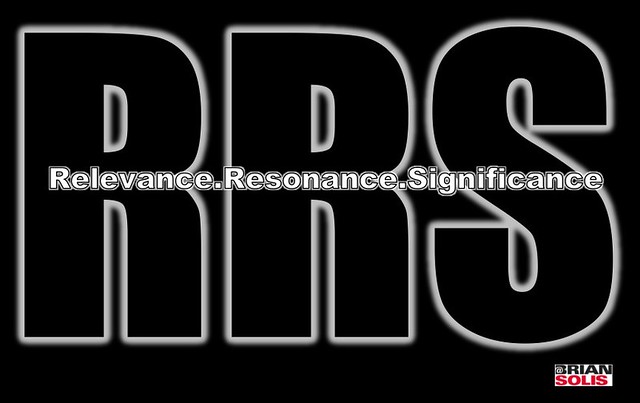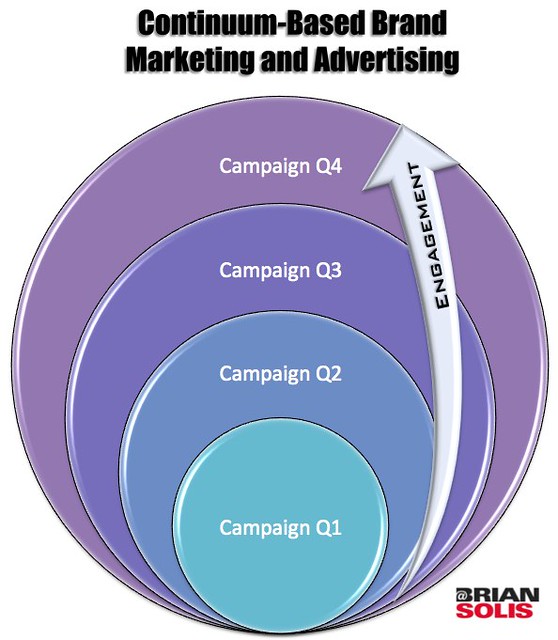
Part Two of Three
In the book Engage!, I use music as a metaphor for the business approach necessary to execute socialized programs flawlessly. I suggest that today, many organizations approach new media with the style of jazz improvisationalists. They possess an incredible ability to jam independently and also together, but they often drift into wild, wonderful solos that may or may not lead the audience back to the heart and soul of the brand purpose and mission. Instead, I suggest that we assemble a team of virtuosos who can perform the dedicated requirements of their roles to contribute to an organized and powerful performance designed to engage and stimulate its audience.
A conductor who possess social prowess and business savvy is necessary to creating and managing a holistic social media program that extends from the top down, from the center outward, from the bottom up, and also from the outside in.The quest to find the conductor and the members of the orchestra rekindle the debate to who owns social media. But, I argue, that the only the person who masters the majesty of music theory, instrumentation, leadership, artistry, and stagemanship can effectively lead and inspire a band of leaders. Simply said, The person and team qualified to lead social are those qualified to do so.
Again, a hybrid approach is essential. In the very least however, they will possess the ability to understand customer touchpoints, channels of influence, market dynamics, challenges and opportunities that face consumers, and how engagement and the production of social objects trigger measurable reactions that impact the bottom line.
Advertising Must Look Beyond Madison Ave.
Advertising, along with every form of marketing, communications, and service, is not immune to the radical changes that amount to nothing less than the complete transformation of business and culture. In my dealings with some of the most creative and forward-thinking advertising agencies, it’s clear that social media is indeed sparking imagination and inspiring experimentation. Yet in a highly critical article that ran in the Washington Post, the advertising industry was labeled as smug and unable to realize the need for innovation. The opening of the article reads more like a bitter generalization than a call to action, but nonetheless, it’s an impression that I’m sure plagues almost every industry in the new content democracy, “Is advertising the next casualty of the ongoing digital tsunami? For now, advertising looks like the patient who developed an asymptomatic form of cancer without realizing how sick he is.”
This view is as extreme as it is dire. However, social at the moment is only one channel that reaches a growing subset of an overall market. Print, broadcast, billboards, and digital are still relevant and in many ways, effective. In the era of 360-degree, holistic marketing, people are now a vocal majority in our markets and as such, social becomes the “last mile” of connecting the dots.
Part of the challenge as well as the opportunity is the embodiment of an age-old cliche, “thinking outside of the box” or “thinking differently.” As Chris Heuer rightly believes, we should think as though “there is no box.” Social Media inspires new thinking that very well assembles the best practices from advertising, marketing, and communications. But to be clear, the future of effective marketing and engagement lies in the reinvention of strategies, media, methodologies, processes, and their respective industries by and large. This starts with rethinking campaign development and deployment to now also integrate the ties that bind them through ongoing relevance and resonance.
Social networks represent new media channels that offer paid and earned platforms that invite ingenuity and contribution. The difference with social networks and other media however, is that consumers are vested in each medium. Social networking is a very personal venture and here, people define their experiences through the relationships they forge, the content they share and consumer, and the devices they use to interact. Here, intention is everything. Programs are not rewarded simply for innovation, gimmicks or artistry. Consumers embrace programs rooted in empathy, aspiration and emotion. While they’re designed with mass appeal, effective initiatives are disguised as personalized communication to hook viewers into an immersive experience. It is the emotional and aspirational connection that entices engagement and response, but it is relevance and some semblance of empowerment that inspires sharing and loyalty.
From Campaign to Continuum
In new media, advertising and creative businesses are criticized for approaching social through the constructs of campaigns. While they spark increased brand awareness, activity, engagement, campaigns inherently place constraints on community and relationship development – unless designed otherwise. They start, incite activity, stop, and then disappear only to re-emerge as a completely different production when time, budgets, and events align.

Indeed campaigns are catalysts for conversation and action. However, in social, creative campaigns must now introduce continuous sequences where adjacent objectives, messages, and storylines are reinforced through ongoing participation. Essentially, campaigns must be strung together through brand-driven conversations and connections.
Consumer attention is increasingly thinning and as a result, we are forced to compete for the moment in order to stay top of mind. At the same time, we must also compete for the future and the only , advertising must now contribute to marketing for the long term through a connected series of creative initiatives that promote rightly versus right now.
Advertising is now presented with a new lease on marketing, one where the right to connect with individuals and audiences is continually renewed through value. If paid media offers mutual benefits, the pace for introducing micro creative programs multiples as they now serve as bridges between larger campaigns.
If we don’t actively compete for mind share, then we lose our placement within the hearts, minds, and decisions of consumers and those who influence their actions.

While creative is designed to perform an intended function or evoke a desired reaction, social networks and the influential beacons that connect potential audiences and ultimately participants create a signal repeater that extends the reach and effect of any campaign across media platforms. And, with research and analysis, we can now identify the specific people within these social graphs that form highly desirable nicheworks, where the long tail is visualized and also revealing. Nicheworks, or what Twitter refers to as “interest graphs” is the next big thing for marketing and business in general. In social networks, meaningful content is only surpassed by context. As such, the formation of contextual networks is both the promise and reward for social networking at large. People invest in knowledge sharing and beneficial relationships and as a result, people establish linkages based on common interests and themes with individuals they may know or wish to know.
The Death of CPM and CPC and the Birth of Resonance
At Twitter’s first annual developer conference, details of its initial foray into advertising were unveiled. Two words that were repeated throughout the conference, resonance and relevance, underscored Twitter’s commitment to creating an advertising platform that would earn the support of the community. As Twitter’s COO Dick Costolo noted, “Promoted Tweets that don’t resonate with users will disappear.” The same is true for any social object and supporting campaign that’s introduced to social networks.
Twitter, Facebook, FourSquare and the like truly believe that the user experience is the source of social media’s future. As such, Twitter is introducing a new metric to measure the effectiveness of advertising campaigns that will only fortify the approach of Hybrid Theory. Initially ads will be based on a CPM (cost per 1,000 impressions or 1,000 qualified individuals exposed to the Tweet). But as Twitter learns about the performance, accuracy, and how the community responds to each program, it will migrate from a model of CPM to one of ROI…yes, Return on Investment.
Using resonance as a metric and also as a form of inspiration, we’re now introduced to multiple axes of engagement to design resonance into our campaigns. Doing so will ensure prolonged existence, visibility, and engagement. Advertisers will need to not only get creative, but also ensure that campaigns and social objects are engaging, actionable, shareable, and valuable. If not, as Costolo said, those campaigns that don’t resonate with uses will “disappear.” As such, Twitter introduced the idea of a resonance score to determine the lifespan of paid social objects. The multiple axes of engagement defining Promoted Tweets for example included:
– Retweets
– @Replies
– #Tag clicks
– Avatar clicks
– Link clicks
– Views after RT
Twitter’s use of the word “resonance” forces relevance into their campaigns in order to trigger positive responses and ultimately word of mouth and measurable activity. And, herein lies the opportunity for Hybrid theory. The key to marketing within social network is to uncover the possibilities, people, and connections that prolong the lifespan of social objects in the stream now and over time. Everything begins with intelligence in order to inspire relevance.

Resonance is the reinforcement or prolongation of social objects. In this example, a Tweet, whether it’s paid or earned, represents a social object as its introduction and exposure possesses the ability to spark conversations. The extent and volume however, are determined by relevance and the shareability of the social object however. The same is true for a campaign introduced in any social network.
Twitter’s metric of resonance could be applied to all forms of social media. Twitter is not only changing communications between people, it also changing how brands and people interact. Resonance represents the impetus for contextualizing and humanizing advertising, in real-time. Without the ability to connect to and inspire people, campaigns will fail miserably. Those that appeal to the emotions and interests of consumers will spark a social effect that reverberates across the social graph online and eventually into the real world.
R.R.S. – Without relevance, we cannot trigger resonance, and without resonance, we cannot establish significance in social media.
Activating the Fifth P of Marketing
Many progressive agencies and internal teams are employing communications professionals to escort campaigns on the long and winding road between media and attention. In the overall socialization of business, marketing is one of the tentacles necessary to reach and grasp consumers. In advertising and marketing, the last mile is best served by connecting messages and people instead of assuming that information goes viral through its own propulsion. Information is just too readily available to ignore and placing people on the front line to personally deliver insight and relevance to decision makers is the difference between temporary visibility and increased presence. In social media, presence is felt and prized. And, this is how we begin to redefine viral marketing…
Several years ago, I had the opportunity to work with Mekanism, a leading San Francisco creative company that builds digital audiences. The team is incredibly gifted and in the projects where we collaborated, they were tasked with developing immersive and “viral” online experiences that pushed the boundaries for even the most radical advertising and branding. However, concepting and building these campaigns would prove straightforward. Luring consumers, clutching their attention, and compelling them to act and share is the true challenge and opportunity in the social economy.
Attention here is thin. Engagement is a form of currency. Recognition and rewards are the deliberate acts of establishing goodwill and earning social capital. In order to bring campaigns to life in social networks, a comprehensive and demanding socialized approach where new influencers and influential consumers are identified and engaged is nothing short of mandatory.
This relationship served as the inspiration and providing ground for Hybrid Theory. And over time, digital influence evolved into a natural extension of creative campaigns, from concept to the Last Mile.
Today Mekanism employs a five-person team that fuses digital PR and influence. And this is only going to grow as advertising seeks to connect campaigns to the very people they wish to inspire and engage. According to Adweek, digital shops are increasingly investing in the creation of communications departments to spread awareness through earned media.
For a creative example of this today, look no further than the Old Spice Guy who is reinvigorating the advertising campaign by creating custom videos for online influencers. It reverses the process of syndication by recruiting people to connect the dots and storylines across social graphs. Videos were initially targeted at Kevin Rose, Alyssa Milano, Justine Bateman, Perez Hilton, Starbucks, among others. Old Spice is also experimenting with Twitter’s Promoted Trends platform, combining earned media (Tweets and posts about these videos), owned media (Old Spice Guy), and paid media (Promoted Tweets) to engage and activate the social web. It creates a confluence of sorts, a concentrated collective that raises awareness and causes action, that if planned accordingly, also rouses desired outcomes.
Here is a sample video to @Alyssa_Milano…you can view more custom videos here.
To successfully tie creative, intention, outcomes, and affinity through paid and earned media, Social Media requires a talented orchestra…and a master conductor.
Continue Reading…
Connect with Brian Solis on Twitter, LinkedIn, Tumblr, Google Buzz, Facebook
___
Please consider reading, Engage!: It might just change the way you think about Social Media

___
Get Putting the Public Back in Public Relations and The Conversation Prism:


___
Image Source: ShutterStock






Brian,this is an excellent huge insight of social media marketing channels tendency! Relevancy and popularity have great influence on every part of media not only on just social marketing or on search engines.
I agree with most of your thinking here, but I think we need to step back and take a look at the big picture. Digital is currently only 10% of all ad spending. I'm using the term “ad” loosely here. By 2014, digital will be 20% of all ad spending according to Forrester. Lot's of growth, right? But spending on Social Media will only amount to 1% of all ad spending. One percent!
Here's the problem. Measuring the effectiveness (ROI) of Social by brand will continue to be a headache for marketers. TV advertising is easier to measure purely because of the scale of the spend. An aircraft carrier makes a bigger wake than a rowboat. Until we can connect the dots between the social activity and the cash register ring, it will remain an ancillary tactic in the minds of brand marketers. Anecdotal evidence can only take us so far.
I can't disagree with you. In some industries, the percentage is much more dramatically skewed. Also, cost is a factor here as well. But, it is experiments that prove the value for helping other industries consider exploration. As I say, other means can not be discounted, but we can not discount social or digital either. For those companies that are experimenting or considering dedicated or expanded social campaigns, a different mind and skill set is necessary. I can only say that my work is rooted in connecting the dots all the way to desired outcomes, including revenue and ROI. My goal for this series is to surface strategies, tactics, and ideas to spark collaboration and experience so that we can learn and grow toeether. It can be done and already is…
I think that truly measuring ROI has always been a challenge, even with traditional media buys. So many “soft,” less measurable factors come into play — increased visibility, brand penetration, goodwill — and these simply can't be measured in a “spend one dollar, get two back” equation. In some ways, digital is almost MORE measurable, because increased clicks are at least something concrete.
I think the key is remains to be measurement over time. As a brand becomes more well known and, hopefully, more respected, conversion follows. It's less about running one ad and then seeing what that ad “did.”
Yes, Old Spice is a prime example of using social media to market. They are doing a tremendous fantastic viral job. I love the way you said context is king and not content, because it's true.
Sometimes connecting that last mile is just the simple convergence of two disparate mediums that suddenly through technology (or happenstance) become connected. Take the ubiquitous advertising poster seen all over town in dry cleaners, retail shops etc. And the equally ubiquitous cell phone. Now place one of those new barcode like “Tags” on the poster. Scan the tag, and your smartphone becomes an extension of the Print ad linking to websites, ticket sales, itunes, facebook, or whatever. All while your are a captive audience waiting to pickup your laundry with nothing better to do.
New ideas can come from any direction, even old ones. You just need to be open to the possibilities.
Indeed Dean. Well stated. When we examine the human side of brands in social media, we can see where technology can't bridge the gap. Let's use Old Spice as an example. The creative and even the engagement is compelling. The question is however, will influencers and their audiences change how they view and embrace “old spice” from their dad's product to their own. The last mile here isn't as much engagement or technology as it is the ability for a brand and brand persona to emotionally connect with this audience.
A word or two about the music analogy: I love both classical music and jazz (Coltrane tradition), have attended numerous concerts, and see jazz as more closely matching the evolving structure of marketing and PR.
Classical music is rigid — the best played pieces are great because they fulfill our expectation of predictability that each note will be played precisely by every musician. Jazz has a defined theme around which musicians play. When players solo they musically “step outside,” and then pleasurably bring us back to the defined theme.
In this evolving technology environment, marketing and PR need the openness and bendy-ness of jazz, which can look up, down, and sideways to connect in real time to what's going on, on another part of the stage.
Bravo Roberta.
Thx Brian. Resonance is the red pill of social media. We're getting over the cowboy stage and entering into more professionalization and integration with other medium and strategies across the organization. It starts with a brand embracing its constituents and as you say Brian create some sort of confluence. I was actually blogging about a Resonance Marketing framework yesterday here http://bit.ly/b44sz6 – If you haven't seen it already @ScepticGeek had a very interesting post today as well on Filtering for Relevance here: http://bit.ly/bpBaMj
I don't see the big difference between this theory and classic marketing, in which you use display, point of sale, and demo; advertising, PR, and events; email marketing, banner ads, and blogs, etc. There are tools. There are always tools. And there are messages. Quite frankly, the messages are the meat of any campaign, no matter what the tools. And the best messages say to the customer, “I care about you. I am listening to you, and when I extend my offering, you have every right to refuse it if it's wrong for you.” Too many brands don't indicate that they are listening, and don't let you “opt out” of a product that doesn't suit you.
ROI is a great buzz word, but most people I talk with don't really know what it is, much less what it should be. It's used primarily as a was to close the conversation because the potential client just doesn't want to spend any more time or money on his effort. What I've found, lately, about the value is social media is not the increase in sales (the traditional ROI) but the reduction in the cost of sales and the sales cycle itself. Cadence Design recently started working with a company called Xuropa that provides a means for potential customers to actually use Cadence semiconductor design tools through the cloud and discuss their projects in real time with Cadence sales engineering. Cadence has used this technology to actively engage with customers around the world, but never have to get on a plane to set up demonstrations and trial projects. The result has been a dramatic reduction in the actual sales cycle, from months to weeks, and in actual headcount for each product area.
Nice article. Maybe this Infographic is also nice on this subject. A nice overview of interruption VS. Engagement marketing: http://www.flickr.com/photos/robertvangeenhuizen/5087103920/sizes/o/
Cheers!
Robert van Geenhuizen